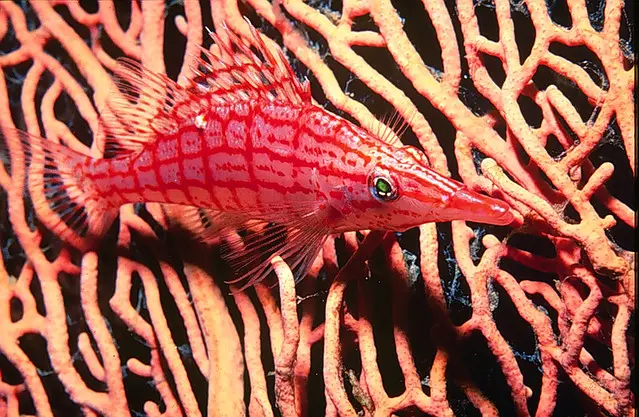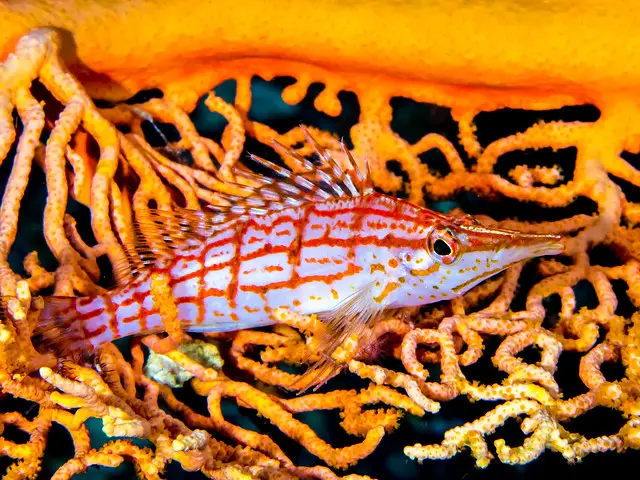Oxucirrhites typus
| Difficulty | Low |
| Minimum Tank Size | 30 Gallons |
| Diet | Carnivore |
| Water Parameters | 72-78 F, pH 8-8.4, Salinity 1.020-1.025 |
| Aggression | Semi-Aggressive |
| Size | 5" |
Caring for a Longnose Hawkfish is a fairly easy task, so long as you avoid a couple pitfalls. Their watchful eyes and skittish attitude make them enjoyable additions to most any tank. However, inexperienced aquarists may add these fish too early, or to tanks with fish that are easy prey. This will often lead to the Longnose Hawkfish attacking its tank mates, leaving only the larger fish safe.
With proper introduction, territory management and feeding schedules the Longnose Hawkfish can be kept peacefully with most any fish.
Longnose Hawkfish Behavior

The hawkfish have one of the more interesting behaviors of the reef communities. Rather than constantly swimming around the tank, looking for food and defending territories, hawkfish will often pick a few spots where it will sit for most of they day. From its vantage point, the hawkfish learns which fish owns which area, where to find food and where is best to hide.
While the Longnose Hawkfish is easily noticeable due to the bright colors it has, they are typically invisible in their natural environment. Red lights cannot penetrate water nearly as well as other colors, meaning their red stripes are difficult to see. Without their red plaid markings the hawkfish would be near impossible to see. This is why they sit still and watch they tank. They are used to being completely concealed, striking only when prey is nearby without endangering themselves.
Diet & Feeding
The Longnose Hawkfish is an excellent hunter and will not go hungry when paired with competitive fish. They will often be the first fish to notice feedings, as their watchful eyes will often focus on the aquarists whenever they walk into view.
The best diet for the Longnose hawkfish will be composed of meats, frozen foods and live feeder shrimp. While it is possible, it is not common for Longnose Hawkfish to eat any form of prepared food. As with most marine fish, feed the hawkfish twice a day.
Feeding the hawkfish is a generally enjoyable part of caring for them. They will often sit on rocks or corals, watching the tank and striking any food it see’s.
Setting up a feeder shrimp breeding system is often recommended, as they can save a good amount of money over time. Just be sure you have enough space and outlets to keep the breeder tank going if you do this.

Longnose Hawkfish Aggression
Overall the Longnose Hawkfish is a peaceful fish. It will generally not start fights with fish of decent size or those slightly smaller than itself. However smaller fish can be attacked if they hawkfish is not well fed. The hungrier the hawkfish the more likely attacks will be.
The primary targets of the Longnose Hawkfish are small fish of any speed, as they are very fast themselves, hermit crabs and small shrimp. This can be a huge issue to tanks that rely on cleaner shrimp and hermit crabs rather than snails.
To combat this issue you will need to introduce the Longnose Hawkfish last or introduce any new tank mates during lights out. The reason these two methods are so effective is due to how we feed our fish, which is by placing food into the tank at the waters surface. Any new tank mates can be perceived as feeding, making the hawkfish much more likely to target them.
If the tank mates are already in place, or sneak in under cover of darkness, the hawkfish will simply keep an eye on them and only attack if they get too hungry.
Generally peaceful, can eat small fish
Sexing & Breeding the Longnose Hawkfish
Male Longnose Hawkfish are generally easy to tell apart from female, however when alone you may have some difficulties. The females is often smaller than the male, while the male is much more vibrant and colorful. The males will also have larger dorsal fins as well as black lines on their fins.
Due to these traits being fairly subtle, it is hard to sex a lone hawkfish. It is generally easiest to find a small local fish store with an owner who orders specific genders of fish.
Thankfully Longnose Hawkfish are protogynous hermaphrodites, meaning they can change genders if there are no males. However one fish must be significantly more dominant than the other. If the two fish are similar in size/aggression a fight will often take place. Due to their razor like mouths, this will not be a loser changes gender. Their fights end one of two ways:
a.) Loser hides until harassed to death
b.) Owner removes on of the fish
If you have ever dealt with hawkfish, you will know removal is basically not an option without dismantling the tank. Instead choose a significantly smaller second hawkfish. If there are no hawkfish smaller than the first, you may need to wait until they grow a bit bigger before breeding.
Remember: Longnose Hawkfish are fast swimmers and need a large tank to breed in. Additionally, more success is seen in tall tanks rather than breeders. This is due to how the mating ritual takes place.
When the hawkfish are not under stress, have paired well and are fed plenty of food, the male will begin scouting for females. This occurs just before lights out, and sometimes just after it. Once he finds the female he is looking for, the two will begin to swim together, often rising to the top of the tank. While near the surface the two fish will release their sperm and eggs into a cloud together. The eggs will be tiny and hard to see. If you intend to remove the eggs it is best to use a container rather than a net. Longnose Hawkfish eggs are extremely fragile and will rarely hatch when removed via net.
For the best results you will need to watch your hawkfish as they meet. Record the time and turn down the water flow in the tank. This will often startle the hawkfish, ending the mating dance. The next day, one hour before the mating dance took place yesterday, turn down the flow again. This will keep the flow from damaging the eggs without startling and stopping the mating process.